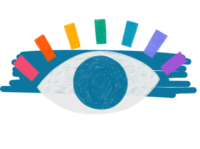Childhood strabismus, commonly referred to as “crossed eyes” or “lazy eye,” is a condition that affects the alignment of the eyes. It can be a source of concern for parents, but with early diagnosis and appropriate treatment, it can often be successfully managed. In this post, we’ll discuss the treatment options available for child strabismus and offer guidance to parents on what to expect.
- Early Diagnosis:
The first step in treating child strabismus is early diagnosis. If you notice that your child’s eyes are not properly aligned, or if there are consistent signs like squinting, head tilting, or poor depth perception, it’s essential to consult a pediatric ophthalmologist or optometrist for a comprehensive eye examination. Early detection is crucial for effective treatment. - Glasses:
In some cases, strabismus may be caused or exacerbated by a refractive error, such as nearsightedness, farsightedness, or astigmatism. Your child may be prescribed glasses to correct these issues. Wearing the appropriate glasses can help improve eye alignment and reduce strabismus-related symptoms. - Vision Therapy:
Vision therapy, also known as orthoptics, is a non-surgical treatment option for strabismus. It involves a series of eye exercises and activities designed to improve eye coordination and control. Vision therapy is often used in conjunction with other treatments and can be particularly effective for certain types of strabismus. - Patching and Atropine Drops:
For children with amblyopia (lazy eye) caused by strabismus, patching one eye or using atropine drops in the stronger eye may be necessary. These methods encourage the weaker eye to work harder and improve visual development. It’s essential to follow your eye care professional’s recommendations regarding the duration and frequency of patching or atropine treatment. - Surgery:
In cases where non-surgical treatments are insufficient or if there is a significant misalignment of the eyes, surgical intervention may be necessary. Strabismus surgery aims to reposition the eye muscles, allowing for improved eye alignment. It’s important to discuss the potential risks and benefits of surgery with your child’s eye specialist. - Ongoing Monitoring:
Treatment for child strabismus often requires ongoing monitoring and follow-up appointments with your eye care professional. Regular check-ups are essential to assess progress, make necessary adjustments to treatment plans, and ensure the best possible outcome for your child. - Emotional Support:
Dealing with a medical condition like strabismus can be emotionally challenging for children. Providing emotional support, encouragement, and a positive environment is crucial. Encourage your child to wear glasses or an eye patch as prescribed, and praise their efforts during vision therapy exercises.
Conclusion:
Childhood strabismus can be effectively treated, especially when diagnosed and addressed early. The key is to consult with a qualified eye care professional who can provide a tailored treatment plan for your child. With the right treatment and support from parents and caregivers, many children with strabismus can enjoy improved eye alignment and vision, ultimately enhancing their overall quality of life.
